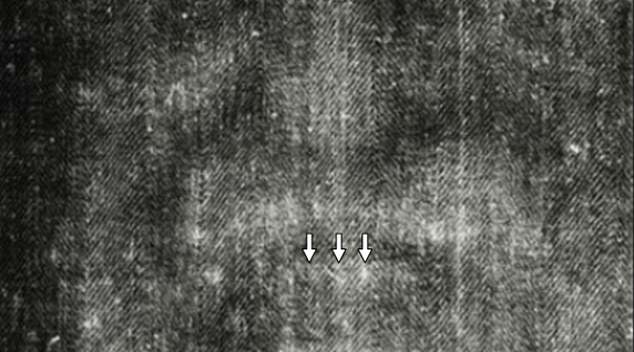A dental surgeon who had achieved professional success felt a void in his life until a rare exhibition in Turin, Italy, changed everything.
Dr John Sottosanti stood before the Shroud of Turin, the ancient linen believed to have wrapped Jesus’ body after the crucifixion, when he noticed something few had ever seen: the faint outline of human teeth beneath the cloth’s imprint.
In a new, yet-to-be peer-reviewed study, Sottosanti revealed that he could discern the biting edges of the lower front teeth, known as the incisal plane.
While past researchers have debated the presence of upper and lower teeth, he concluded that only the lower teeth are visible, likely because the upper teeth were hidden by the mustache and lips.
‘Immediately after death, a phenomenon called primary flaccidity occurs, where all the muscles in the body relax, including those in the jaw,’ Sottosanti explained. ‘This can lead to the jaw dropping open and the teeth separating.’
The detail, he said, is extraordinary: the lower teeth on the Shroud suggest the body emitted a burst of radiant energy at the moment of the Resurrection, powerful enough to imprint even the smallest anatomical features.
‘Suppose teeth, located behind the lower lip, are indeed evident in the image on the Shroud,’ Sottosanti said.
‘In that case, their presence lends credence to the theory that a burst of energy was released at the time of the resurrection, allowing them to be in the image.’

A dental surgeon says there are visible teeth on the Shroud. Dr John Sottosanti believes the teeth were a result of the resurrection just as the image of the human body
However, not all experts are convinced by the conclusion.
Dr Kelly Kearse, an immunologist who has extensively studied the Shroud of Turin, told the Daily Mail: ‘The issue of visible teeth on the Shroud is a subjective one and has been around for several years.
‘In my opinion, for what it’s worth, I believe it is difficult to tell because of the banding of the cloth, which appears white in the negative image.’
Despite the skepticism, Sottosanti cited multiple published papers noting tooth observations in the imprint.
These included images taken in 1982 by archaeological chemist Dr Giles Carter, who suggested that X-radiation emanating from within the body may have created the Shroud’s image, including teeth and bones.
The study also highlighted the work of Dr Alan Whanger, Professor Emeritus at Duke University Medical Center, and his wife, Mary, who developed the ‘Polarized Image Overlay Technique’ to study the Shroud.
By overlaying positive and negative images with a polarized filter, they claimed to see 20 upper and lower teeth, including roots.
In a 2023 interview, New Testament scholar Gary Habermas said: ‘You can see very clearly what appears to be teeth and roots… You can see the roots through the hair and through the skin.’

Several studies have suggested that teeth are visible on the Shroud, including one that claimed roots are also present

The Shroud of Turin is housed in Italy and is only put on display for the public during rare events
Sottosanti countered, saying: ‘Habermas believes you can see all the roots of the upper and lower teeth. I disagree, since throughout the Shroud image, there is a melding of the image with the pattern of the weave.
‘In the area of the lower lip, at a certain point as you move away from the crowns of the teeth, the weave becomes more prominent, and the vertical striations appear to be roots.
These striations extend beyond the normal length of the teeth, so it is the weave, not the actual roots. Vertical striations are also visible in the cheeks, chin, and other areas of the image.’
The dental surgeon said his expertise in oral anatomy and surgical experience allowed him to identify what he believes are parts of the lower teeth.
He argued that these teeth appear lighter than the surrounding jawbone, suggesting the body’s imprint captured even fine anatomical details.

The 14-foot-long Shroud of Turin is touted as wrapping used for Jesus’ body after the crucifixion, which shows a faint, bloodstained pattern of a man with his arms folded in front
The discovery, Sottosanti said, is extraordinary: the lower teeth imply that at the moment of the Resurrection, the body released a burst of radiant energy powerful enough to imprint even the smallest features onto the linen.
‘Suppose teeth, located behind the lower lip, are indeed evident in the image on the Shroud,’ Sottosanti said.
‘In that case, their presence lends credence to the theory that a burst of energy was released at the time of the resurrection, allowing them to be in the image.’
The Shroud features a faint, brownish image of a five-foot, six-inch-tall man with sunken eyes, wounds on various parts of his body that match the injuries suffered during Jesus’ crucifixion.
More than 170 peer-reviewed academic papers have been published about the mysterious linen since the 1980s, with many concluding it is genuine.
A 1980 study tested a small corner of the shroud and dated it to some time between 1200 and 1400.
However, many researchers have suggested that the sample was a repair done centuries ago.
The burial cloth has captivated the imagination of historians, church chiefs, skeptics and Catholics since it was first presented to the public in the 1350s.
French knight Geoffroi de Charny gave it to the dean of the church in Lirey, France, proclaiming it as the Holy Shroud.
This article was originally published by a www.dailymail.co.uk . Read the Original article here. .

